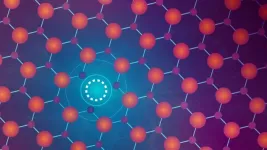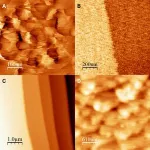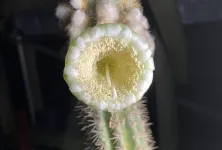(Press-News.org) Silicon computer chips have served us well for more than half a century. The tiniest features on chips currently sold are approximately 3 nanometers — a startlingly small size given that a human hair is roughly 80,000 nanometers wide. Reducing the size of features on chips will help us meet our endless need for more memory and processing power in the palm of our hand. But the limit of what can be achieved with standard materials and processes is near.
Researchers at the U.S. Department of Energy’s (DOE) Princeton Plasma Physics Laboratory (PPPL) are applying their expertise in physics, chemistry and computer modeling to create the next generation of computer chips, aiming for processes and materials that will produce chips with smaller features.
“All of our existing electronic devices use chips made up of silicon, which is a three-dimensional material. Now, many companies are investing a lot in chips made up of two-dimensional materials,” said Shoaib Khalid, an associate research physicist at PPPL. The materials actually exist in three dimensions, but they are so thin –– often made up of only a few layers of atoms — that scientists have taken to calling them 2D.
Khalid, together with PPPL’s Bharat Medasani and Anderson Janotti from the University of Delaware, investigated one potential silicon replacement: a 2D material known as a transition-metal dichalcogenide (TMD). Their new paper, published in the journal 2D Materials, details the variations that can occur in the atomic structure of TMDs, why they happen and how they affect the material. Information about these variations lays the groundwork for refining the processes needed to create next-generation computer chips. Ultimately, the goal is to design plasma-based manufacturing systems that can create TMD-based semiconductors made to the precise specifications required for the application.
TMD: A tiny metal sandwich
A TMD can be as thin as three atoms high. Think of it like a tiny metal sandwich. The bread is made of a chalcogen element: oxygen, sulfur, selenium or tellurium. The filling is a layer of transition metal — any metal from groups 3 to 12 in the periodic table of elements.
A bulk TMD has five or more layers of atoms. The atoms are arranged in a crystal structure or lattice. Ideally, the atoms are organized in a precise and consistent pattern throughout the lattice. In reality, small alterations can be found in the pattern. One spot in the pattern might be missing an atom, or an atom might be found in an odd location. Scientists call these alterations defects, but they can have a beneficial impact on the material.
Some TMD defects, for example, can make the semiconductor more electrically conductive. Good or bad, it is critical that scientists understand why defects happen and how they will affect the material so they can incorporate or eliminate these defects as necessary. Understanding common defects also allows the researchers to explain the results from past experiments with TMDs.
“When bulk TMDs are made, they have excess electrons,” Khalid said, adding that researchers were not sure why these excess negatively charged particles were present. “In this work, we explain that the excess electrons can be caused by hydrogen.”
The researchers came to this conclusion after calculating the amount of energy that would be required to form different kinds of TMD defects. They looked at defects involving chalcogen vacancies, which were previously known to be present in TMDs, and defects involving hydrogen because this element is often present during the chip manufacturing process. Researchers are particularly interested in finding out which defects require minimal formation energy because these are the ones that are likely to occur — it doesn’t take much energy for them to happen!
The team then investigated the role of each of the low-formation-energy defects. Specifically, they wanted to know how each defect configuration might impact the electrical charge of the material. The researchers found that one of the defect configurations involving hydrogen provides excess electrons, which creates negatively charged semiconductor material, known as an n-type. Computer chips are made using combinations of n-type semiconductor material and positively charged, or p-type, material.
Shedding light on missing chalcogens
The other type of defect explored in the paper is known as a chalcogen vacancy: a missing atom of oxygen, sulfur, selenium or tellurium, depending on the type of TMD. The researchers focused on explaining the results of past experiments on flakes of the bulk TMD material molybdenum disulfide. The experiments, which involved shining light on the TMD, showed unexpected frequencies of light coming from the TMD. These unexpected frequencies, the researchers found, could be explained by the movement of electrons related to the chalcogen vacancy.
This model shows the spot where the missing chalcogen atoms should be, as represented by the black circle in the center of an otherwise undisturbed pattern of atoms. This view looks down on the middle layer of the TMD. (Image credit: Shoaib Khalid, Bharat Medasani and Anderson Janotti / PPPL and the University of Delaware)
“This is a common defect. They can often see it from the images of scanning tunneling microscopes when they grow the TMD film,” Khalid said. “Our work provides a strategy to investigate the presence of these vacancies in the bulk TMDs. We explained past experimental results shown in molybdenum disulfide, and then we predicted a similar thing for other TMDs.”
The process suggested by the researchers involves analyzing the TMD for defects using measurement techniques called photoluminescence to see which frequencies of light are emitted by the material. The peak frequency of light can be used to determine the electron configurations of the atoms in the TMD and the presence of chalcogen defects. The journal article includes information about the frequencies that would be emitted by five types of TMDs with chalcogen vacancies, including molybdenum disulfide. The results, therefore, provide a guideline for investigating chalcogen vacancies in future experiments.
PPPL is mastering the art of using plasma — the fourth state of matter — to solve some of the world's toughest science and technology challenges. Nestled on Princeton University’s Forrestal Campus in Plainsboro, New Jersey, our research ignites innovation in a range of applications including fusion energy, nanoscale fabrication, quantum materials and devices, and sustainability science. The University manages the Laboratory for the U.S. Department of Energy’s Office of Science, which is the nation’s single largest supporter of basic research in the physical sciences. Feel the heat at https://energy.gov/science and https://www.pppl.gov.
END
Detecting defects in tomorrow’s technology
New research enhances our understanding of a likely candidate for next-generation computer chips
2024-07-09
ELSE PRESS RELEASES FROM THIS DATE:
It takes a cool microscope and antifreeze to really look at ice
2024-07-09
Ice in nature is surrounded by liquid most of the time, and therefore it is key to understand how ice and liquid interact. A Kobe University and Institute for Molecular Science study could now for the first time directly observe the precise shape of ice at the interface between ice and liquid – by using antifreeze and a refrigerated microscope.
When we slide on ice, when snowflakes form, when we lick ice cream, the surface of the ice is always covered with liquid water, and understanding the interaction between the ...
First local extinction in the US due to sea level rise
2024-07-09
The United States has lost its only stand of the massive Key Largo tree cactus in what researchers believe is the first local extinction of a species caused by sea level rise in the country.
The Key Largo tree cactus (Pilosocereus millspaughii) still grows on a few scattered islands in the Caribbean, including northern Cuba and parts of the Bahamas. In the United States, it was restricted to a single population in the Florida Keys, first discovered in 1992 and monitored intermittently since.
Salt water intrusion from rising seas, soil depletion from hurricanes and high tides, and herbivory by mammals had put significant pressure ...
Empowering Ugandan female youth with self-esteem, self-efficacy, and gratitude using Transcendental Meditation
2024-07-09
A peer-reviewed study published today in Health Care for Women International found that the Transcendental Meditation® (TM®) technique can empower the lives of female youth living under conditions of poverty in the city slums of Kampala, Uganda. Outcomes include increased self-esteem, self-efficacy, and gratitude; and decreased tiredness, worry, and excessive alcohol use. TM helped these young women improve their mental and physical health, as well as their relations with family and community members.
“The ...
Brian Wachtel is promoted to Chief Development Officer at NFCR
2024-07-09
The National Foundation for Cancer Research (NFCR) proudly announces the promotion of Brian Wachtel to Chief Development Officer. Brian will continue his responsibilities as the Executive Director, and his expanded role will further enhance his leadership within the organization.
Brian joined the National Foundation for Cancer Research in September 2016 as the Director of Corporate Partnerships & Special Events. In that capacity, he was in charge of organizing and expanding NFCR’s community outreach events. One of his important ...
Digital self-harm surges among U.S. teens from 2016 to 2021
2024-07-09
Adolescents worldwide have embraced social media and online platforms for self-expression and to explore their identity. This freedom, however, can lead to risky behaviors, especially with limited adult supervision. For example, digital self-harm is a recent, emerging trend where individuals anonymously post or share hurtful content about themselves online. This behavior can be mistaken for mistreatment by others, yet the perpetrator and victim are the same person.
First identified in 2010, digital self-harm has not received the same amount of scholarly scrutiny as other forms of self-directed abuse and has not been widely addressed by adults ...
UTSA joins new consortium dedicated to nuclear security and nonproliferation
2024-07-09
The University of Texas at San Antonio (UTSA) has joined one of two newly established university consortia committed to nuclear security and nonproliferation. The consortia were awarded $50 million in cooperative agreements by the Office of Defense Nuclear Nonproliferation in the U.S. Department of Energy’s National Nuclear Security Administration (DOE NNSA).
“The pressing challenges of nuclear security and nonproliferation require a concerted effort from experts across the country,” said JoAnn Browning, UTSA interim vice president for research. ...
Diabetes increases the risk of failure in spinal fusion procedures
2024-07-09
A new study from orthopaedic researchers at The University of Toledo has found lumbar spinal fusion procedures are far more likely to fail in individuals with diabetes.
“We’ve known for a long time that diabetic patients are at high risk of infection from any surgery, including spinal fusion,” said Dr. Hossein Elgafy, a professor of orthopaedics in the College of Medicine and Life Sciences and chief of spine surgery at UTMC. “More recently, however, physicians have taken a closer look at the high ...
Brain-computer interface therapy for stroke survivors
2024-07-09
A personalized brain-computer interface therapy, RehabSwift, significantly enhances hand mobility for stroke survivors. Strokes often lead to impaired hand function, presenting substantial challenges in daily activities. Sam Darvishi and colleagues developed and tested a brain-computer interface therapy that translates imagined hand movements into real actions using a personalized algorithm and bionic hands. The study involved twelve chronic stroke survivors from South Australia who had limited use of their arms but retained clear thinking abilities. Throughout 18 sessions, participants used the RehabSwift system, which included a special cap that ...
SynGAP Research Fund (SRF) increases support for SYNGAP1 organoid research at the University of Southern California’s Quadrato Lab
2024-07-09
MILL VALLEY, Calif. – July 9, 2024 – SynGAP Research Fund (SRF), a 501(c)(3) public charity whose mission is to improve the quality of life for patients suffering from SYNGAP1-Related Disorders (SRD) through the research and development of treatments, therapies, and support systems, has awarded a $130,000 grant to the University of Southern California’s Quadrato Lab to inspect and stratify the effects of specific SYNGAP1 variants on their patient-derived neuronal model system, furthering the world’s understanding ...
Study finds 1 in 12 patients labeled as having ‘benign’ results actually had high-risk prostate cancer
2024-07-09
New research highlights the challenge of balancing the risks of overdiagnosing and underdiagnosing prostate cancer early enough to intervene and minimize risk of death. Recently, some experts have called for the lowest grade of prostate cancer—biopsy Gleason Grade Group (GGG) 1—to be reclassified as ‘benign.’ But a new study led by a researcher from Mass General Brigham has found that many patients with a biopsy GGG1 may have a more aggressive cancer than their biopsy alone suggests.
By looking at data from more than 10,000 patients at a university in Germany, researchers found that at least 8 percent of patients with this ...
LAST 30 PRESS RELEASES:
Securing AI systems against growing cybersecurity threats
Longest observation of an active solar region
Why nail-biting, procrastination and other self-sabotaging behaviors are rooted in survival instincts
Regional variations in mechanical properties of porcine leptomeninges
Artificial empathy in therapy and healthcare: advancements in interpersonal interaction technologies
Why some brains switch gears more efficiently than others
UVA’s Jundong Li wins ICDM’S 2025 Tao Li Award for data mining, machine learning
UVA’s low-power, high-performance computer power player Mircea Stan earns National Academy of Inventors fellowship
Not playing by the rules: USU researcher explores filamentous algae dynamics in rivers
Do our body clocks influence our risk of dementia?
Anthropologists offer new evidence of bipedalism in long-debated fossil discovery
Safer receipt paper from wood
Dosage-sensitive genes suggest no whole-genome duplications in ancestral angiosperm
First ancient human herpesvirus genomes document their deep history with humans
Why Some Bacteria Survive Antibiotics and How to Stop Them - New study reveals that bacteria can survive antibiotic treatment through two fundamentally different “shutdown modes”
UCLA study links scar healing to dangerous placenta condition
CHANGE-seq-BE finds off-target changes in the genome from base editors
The Journal of Nuclear Medicine Ahead-of-Print Tip Sheet: January 2, 2026
Delayed or absent first dose of measles, mumps, and rubella vaccination
Trends in US preterm birth rates by household income and race and ethnicity
Study identifies potential biomarker linked to progression and brain inflammation in multiple sclerosis
Many mothers in Norway do not show up for postnatal check-ups
Researchers want to find out why quick clay is so unstable
Superradiant spins show teamwork at the quantum scale
Cleveland Clinic Research links tumor bacteria to immunotherapy resistance in head and neck cancer
First Editorial of 2026: Resisting AI slop
Joint ground- and space-based observations reveal Saturn-mass rogue planet
Inheritable genetic variant offers protection against blood cancer risk and progression
Pigs settled Pacific islands alongside early human voyagers
A Coral reef’s daily pulse reshapes microbes in surrounding waters
[Press-News.org] Detecting defects in tomorrow’s technologyNew research enhances our understanding of a likely candidate for next-generation computer chips










